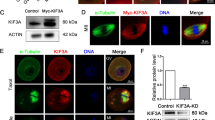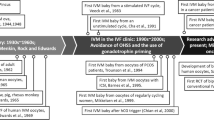Hydrogen peroxide (H2O2) is known to induce cell cycle arrest and apoptosis in various somatic cell types cultured in vitro. We hypothesize that this reactive oxygen species (ROS) could modulate cell cycle and induce morphological features characteristics of apoptosis in oocytes cultured in vitro. To test this hypothesis, immature and mature oocytes were cultured in medium containing various doses of H2O2 with or without caspase-3 inhibitor for various times. The treatment of H2O2 induced germinal vesicle break down (GVBD) in all immature oocytes followed by initiation of shrinkage. Some of immature oocytes (but not mature oocytes) also showed membrane blebbing. On the other hand, H2O2 treatment inhibited first polar body emission in mature oocytes just prior to initiation of shrinkage. The cytoplasmic granulation and fragmentation into apoptotic bodies were observed in mature oocytes during later stages of H2O2 treatment. The shrinkage was induced by H2O2 in a dose- and time-dependent manner in both immature and mature oocytes. Although, H2O2-induced degeneration was observed in both immature and mature oocytes after 2.0 hrs of treatment, immature oocytes were more susceptible to undergo quick shrinkage, membrane blebbing and degeneration. Co-addition of caspase-3 inhibitor prevented shrinkage and degeneration of both immature and mature oocytes except membrane blebbing that was observed at higher doses of H2O2 after 1.0 hr of culture. Treatment of H2O2 induced bax protein expression (3 times), DNA fragmentation and caspase-3 activity (2.5 times) in oocytes undergoing morphological apoptotic changes. These findings clearly suggest that H2O2 induced GVBD in immature oocytes, inhibited first polar body extrusion in mature oocytes prior to initiation of morphological changes characteristic of apoptosis such as shrinkage, membrane blebbing and cytoplasmic fragmentation prior to degeneration.
Similar content being viewed by others
References
Buttke TM, Sandstrom PA. Oxidative stress as a mediator of apoptosis. Immunol Today 1994; 15: 7–10.
Takahashi Y, Orga Y, Suzuki KT. Synchronized generation of reactive oxygen species with the cell cycle. Life Sci 2004; 75: 301–311.
Wiener-Megnazi Z, Vardi L, Lissak A, et al. Oxidative stress indices in follicular fluid as measured by the thermochemiluminescence assay correlate with outcome parameters in in vitro fertilization. Fertl Sterl 2004; 82: 1171–1176.
Pasqualotto EB, Agrawal A, Sharma RK, et al. Effect of oxidative stress in follicular fluid on the outcome of assisted reproductive procedures. Fertl Sterl 2004; 81: 973–976.
Blondin P, Coenen K, Sirard MA. The impact of reactive oxygen species on bovine sperm fertilizing ability and oocyte maturation. J Androl 1997; 18: 454–460.
Takami M, Preston SL, Toyloy VA, Behrman HR. Antioxidant reversibly inhibit the spontaneous resumption of meiosis. Am J Physiol Endocrinol Metab 1999; 276: E684–688.
Takami M, Preston SL, Behrman HR. Eicosatetraynoic and eicosatetraynoic acids, lipoxygenase inhibitors block meiosis via antioxidant action. Am J Physiol Cell Physiol 2000; 278: C646–50.
Behrman HR, Kodaman PH, Preston SL, Gao S. Oxidative stress and ovary. J Soc Gynecol Investig 2001; 8: S40–42.
Chen Q, Ames BN. Senescence-like growth arrest induced by hydrogen peroxide in human diploid fibroblast F65 cells. Proc Nat Acad Sci USA 1994; 91: 4130–4134.
Clompton DA, Saltman P. Low levels oxidative stress cause cell cycle specific arrest in cultured cell. Biochem Biophys Res Commun 1995; 210: 189–196.
Bladier C, Wolvetang EJ, Huchinson P, de Hann JB, Kola I. Response of a primary human fibroblast cell line to H2O2: Senescence-like growth arrest or apoptosis? Cell Growth Differ 1997; 8: 589–598.
Liu L, Trimarchi JR, Keefe DL. Thiol oxidation induced embryonic cell death in mice prevented by antioxidant Dithiothretol. Biol Reprod 1999; 61: 1162–1169.
Liu L, Keefe DL. Cytoplasm mediated both developmental and oxidation induced apoptotic cell death in mouse zygote. Biol Reprod 2000; 62: 1828–1834.
de-Matos DG, Gasparrini B, Pasqualini SR, Thompson JG. Effect of glutathione synthesis stimulation during in vitro maturation of bovine oocytes on embryo development and intracellular peroxide content. Theriogenology 2002; 57: 1443–1451.
Kitagawa Y, Suzuki K, Yoneda A, Watanabe T. Effect of oxygen concentration and antioxidants on the in vitro developmental ability, production of reactive oxygen species (ROS), and DNA fragmentation in porcine embryos. Theriogenology 2004; 62: 1186–1197.
Tetemoto H, Muto N, Shinjo A, Nakada T. Protection of porcine oocytes against cell damage caused by oxidative stress during in vitro maturation: Role of superoxide dismutase activity in porcine follicular fluid. Biol Reprod 2004; 71: 1150–1157.
Meikrantz W, Schlegel R. Apoptosis and cell cycle. J Cell Biochem 1995; 58: 160–174.
Gil-Gomez G, Berns A, Brady HJM. A link between cell cycle and cell death: Bax and Bcl-2 modulate Cdk2 activation during thymocyte apoptosis. EMBO J 1998; 17: 7209–7218.
Yang HW, Hwang KJ, Kwan HC, Kim HS, Choi KW, Oh KS. Detection of reaction oxygen species (ROS) and apoptosis in human fragmented embryo. Human Reprod 1998; 13: 998–1002.
Tatemoto H, Sakurai N, Muto N. Protection of porcine oocytes against apoptotic cell death caused by oxidative stress during in vitro maturation: Role of cumulus cells. Biol Reprod 2000; 63: 805–810.
Guerin P, Mounatassim S, Menezo Y. Oxidative stress and protection against reactive oxygen species in the pre-implantation embryo and its surroundings. Hum Reprod Update 2001; 7: 175–189.
Yu BP. Cellular defenses against damage from reactive oxygen species. Physiol Rev 1994; 74: 139–162.
Fridovich I. Biological effects of superoxide radical. Arch Biochem Biophys 1986; 247: 1–11.
Mc Cord JMA, Day ED. Superoxide-dependent production of hydroxyl radicals catalyzed by an iron-EDTA complex. FEBS Lett 1978; 86: 139–142.
Singh D, Pandey RS. Changes in catalase activity and hydrogen peroxide level in rat ovary during estrous cycle and induction of catalase in rat ovary by estradiol-17β. Ind. J Exp. Biol. 1997; 36: 421–423.
Nasr-Esfahani MH, Aitken JR, Johnson MH. Hydrogen peroxide levels in mouse oocytes and early cleavage stage embryos developed in vitro or in vivo. Development 1990; 109: 501–507.
Chan PJ, Calinisan JH, Corselli JU, Patton WC, King A. Updating quality control assays in the assisted reproductive technologies laboratory with a cryopreserved hamster oocyte DNA cytogenotoxicity assay. J Assist Reprod Genet 2001; 18: 129–134.
Fuzino Y, Ozaki K, Yamamastu S, et al. DNA fragmentation of oocytes in aged mice. Hum Reprod 1996; 11: 1480–1483.
Perez GI, Tao X-Z Tilly JL. Fragmentation and death (a.k.a. apoptosis) of ovulated oocytes. Mol Hum Reprod 1999; 5: 414–420.
Wu Ji, Zhang L, Wang X. Maturation and apoptosis of human oocytes in vitro are age-related. Fertl Sterl 2000; 74: 1137–1141.
Jurisicova A, Acton BM. Deadly decisions: The role of genes regulation programmed cell death in human preimplantation embryo development. Reproduction 2004; 281–291.
Roth Z, Hansen PJ. Involvement of apoptosis in disruption of developmental competency of bovine oocytes by heat shock during maturation. Biol Reprod 2004; 71: 1898–1906.
Chaube SK, Misro MM. Effect of styrene maleic anhydride (SMA) on viability and integrity of isolated rat oocytes in vitro. Contraception 2002; 66: 469–472.
Bradford M. A rapid and sensitive method for the quantitation of microgram quantities of protein utilizing the principle of dye-binding. Analyst Biochem 1976; 72: 242–254.
Towbin H, Staehelin T, Fordon J. Electrophoretic transfer of proteins from polyacrylamide gels to nitrocellulose sheets: Procedure and some applications. Proc Natl Acad Sci USA 1979; 76: 4350–4354.
Wassarman PM, Albertini DF. The mammalian ovum. In: Knobil E and Neill JD eds. The Physiology of Reproduction. IInd ed. 1994; 1; 79–122.
Aitken RJ. Free redicals, lipid peroxidation and sperm function. Reprod Fertl Dev 1995; 7: 659–668.
Parlow AF. Influence of differences in the persistence of luteinizing hormones in blood on their potency in the ovarian ascorbic acid depletion bioassay. Endocrinology 1972; 91(4): 1109–12.
Laloraya M, Kumar GP, Laloraya MM. Histochemical study of superoxide dismutase in the ovary of the rat during the oestrous cycle. J Reprod Fertl 1989; 86: 583–587.
Laloraya M, Pradeep KG, Laloraya MM. Changes in the levels of superoxide anion radical and superoxide dismutase during the estrous cycle of Rattus norvegicus and induction of superoxide dismutase in rat ovary by lutropin. Biochem Biophys Res Commun 1988; 157: 146–153.
Chance B, Sies H, Boveris A. Hydroperoxide metabolism in mammalian organs. Physiol Rev 1979; 59: 527–605.
Meister A. Selective modification of glutathione metabolism. Science 1983; 220: 472–477.
Leyens G, Knoops B, Donnay I. Expression of peroxidoxins in bovine oocytes and embryos produced in vitro. Mol Repord Dev 2004; 69: 243–251.
Terranova PF, Tayler CC. Apoptosis (cell death). In Encyclopedia of reproduction 1999; 1: 261–273.
Tada-Okawa S, Oikawa S, Kawanishi M, Yamada M, Kawanishi S. Generation of hydrogen peroxide precedes loss of mitochondrial membrane potential during DNA alkylation-induced apoptosis. FEBS Lett 1999; 442: 65–69.
Men H. Manson RL, Parrish JJ, Rutledge JJ. Degeneration of cryopreserved bovine oocytes via apoptosis during subsequent culture. Cryobiology 2003; 47: 73–81.
Hao Y, Lai L, Mao J, Im GS, Bonk A, Prather RS. Apoptosis in parthenogenetic preimplantation porcine embryos. Biol Reprod 2004; 70: 1644–1649.
Ma W, Zhang D, Hou Y, et al. Reduced expression of MAD2,Bcl-2 and MAP kinase activity in pig oocytes after in vitro aging are associated with defects in sister chromatids segregation during meiosis II and embryo fragmentation after activation. Biol Reprod 2005; 72: 373–383.
Henkel R, Hajimohammad M, Stalf T, et al. Influence of deoxyribonucleic acid damage on fertilization and pregnancy. Ferl Sterl 2004; 81: 965–972.
Yuan YQ, Peelman LJ, Williams JL, et al. Mapping and transcription profiling of CASP1,2,3,6,7 and 8 in relation to caspase activity in the bovine cumulus- oocyte complex. Anim Genet 2004; 35: 234–237.
Jurisicova A, Antenos M, Varmuza S, Tilly JL, Casper RF. Expression of apoptosis-related gene during human preimplantation embryo development: Potential roles for the Harakiri gene product and caspase-3 in blastomere fragmentation. Human Reprod 2003; 9: 133–141.
Author information
Authors and Affiliations
Corresponding author
Rights and permissions
About this article
Cite this article
Chaube, S.K., Prasad, P.V., Thakur, S.C. et al. Hydrogen peroxide modulates meiotic cell cycle and induces morphological features characteristic of apoptosis in rat oocytes cultured in vitro. Apoptosis 10, 863–874 (2005). https://doi.org/10.1007/s10495-005-0367-8
Issue Date:
DOI: https://doi.org/10.1007/s10495-005-0367-8




